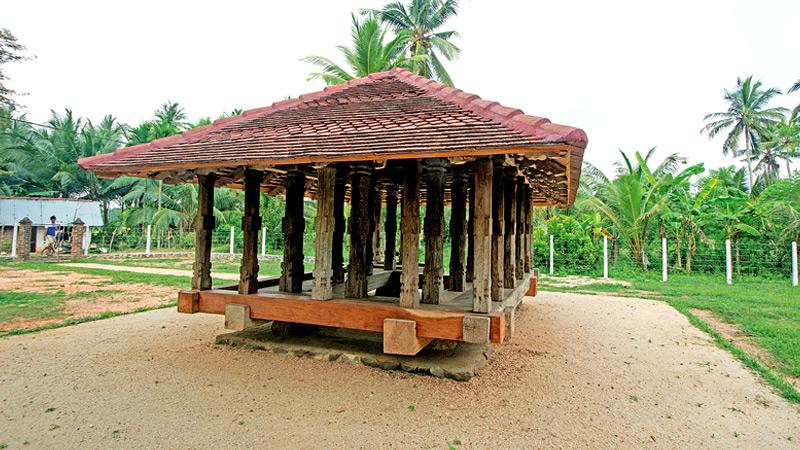
 Ambalama’ is a Sinhala word for a wayside rest-house. I first saw one when I was trekking to Sri Pada, (Adam’s Peak) as a boy with my grandmother in latter part of 1970s. I saw several buildings along the trek up to the peak where weary pilgrims stop over to take a respite from their long journey.
Ambalama’ is a Sinhala word for a wayside rest-house. I first saw one when I was trekking to Sri Pada, (Adam’s Peak) as a boy with my grandmother in latter part of 1970s. I saw several buildings along the trek up to the peak where weary pilgrims stop over to take a respite from their long journey.
Ambalama was closely associated with the culture of Sri Lankan community. It was also a great necessity, which was embedded in their day-to-day life. On a long haul journey, people pull over at roadside hotels and rest houses to freshen up and have some tea. Those days, the weary travellers needed a place of refuge as they traversed various footpaths, which through long stretches of fields and forests, connecting to their destination.
Most of the Ambalamas we see today are located on a rocky boulder, near rivers, paddy fields that the fatigued wayfarer could find an easy supply of water to quench his thirst, wash his face and do the laundry. It also served as a meeting place for the village folk, where they exchanged gossip, pleasantries, and discussed politics. Some would recite poetry in a contest with each other or challenge each other in solving riddles. Then there were those who would gather at the Ambalama to praise the manifold mighty deeds of the reigning king.
Back in those days, pilgrims’ and carters’ travels lasted weeks or even months. These long journeys were often by foot or by cart. Each carried their provisions and stopped for rest at Ambalamas constructed and designed as architecturally simple buildings for providing shelter to weary travelers, free. It was also a place where travellers could rest, eat, wash and possibly stay overnight.
 Travel itself has rapidly changed over time, and today, Ambalamas still stand along the highways reminding us of the days gone by. Recently, we had an opportunity to see one such astonishing Ambalama in the Kurunegala District. It is the Panavitiya Ambalama, situated in a sleepy village close to Matiyagane near Narammala in the Kurunegala District.
Travel itself has rapidly changed over time, and today, Ambalamas still stand along the highways reminding us of the days gone by. Recently, we had an opportunity to see one such astonishing Ambalama in the Kurunegala District. It is the Panavitiya Ambalama, situated in a sleepy village close to Matiyagane near Narammala in the Kurunegala District.
If you are travelling on the Negombo-Kurunegala route, before reaching Narammala Town, turn to your left to the lane that leads to the Matiyagane School. You need to travel about four kilometres on road to reach the Ambalama. From Kurunegala city, it’s only a half-hour drive. The Panavitiya Ambalama is situated next to Lankathilakarama Vihara on a flat land at the border of a stretch of picturesque coconut plantation.
It didn’t take long for us to discover its wealth of wooden wonder. As we carefully entered its inside the carvings seemed to overwhelm us, covering almost every available space – unique concepts and combinations of art themes as varied as its numbers.
The pillars that held the humble roof of Panavitiya Ambalama were abundantly decorated. The nine inner pillars some six feet in height were so profusely carved that I almost held my breath. Exquisitely carved rectangular squares half way on the pillars showed wood carvings. The nineteen pillars that formed the outer posts were less elaborately carved. But displayed an elegance beyond compare.
Today, you will find a few wayside shelters across Sri Lanka that have architectural and archeological value. The Panavitiya Ambalama is a classic example of Sri Lankan indigenous architecture. Even though most of the ancient Ambalamas went into a state of neglect and disrepair, the renovations and restorations of the Ambalama in Panavitiya was undertaken by the Archaeological Department and completed with assistance provided by the Department of Cultural Affairs.
The woodwork of the roof consisted beams, posts, rafters and reepers of exceptional wooden ornamentation. Ambalama is supported by four wooden pillars. They sometimes displayed ornate carvings and motifs that symbolise the prominent cultural feature of that period. The value of the Panavitiya Ambalama lies in its elaborate woodwork of beams and posts. Some of these carvings bear resemblance to the ones at Embekke Devale in Kandy. Among these carvings which date back to the 18th century are scenes and sights of everyday village life, floral creepers, wrestlers, dancers, musicians, and mythical creatures. The numbers of the woodwork of the roof consist of beams, posts, rafters and reepers.
The Department of Archaeology has renovated and restored its wood carvings in 2016. It is believed that the Ambalama may have stood as a rest hall enroute to an ancient foot path leading from Dambadeniya to Kurunegala and Yapahuwa.
Today it stands as a unique monument of our ancient transport system. - A witness to may be a million passers-by. And we sat down to enjoy a meal of gram bought from wayside boutique close to the Ambalama.
